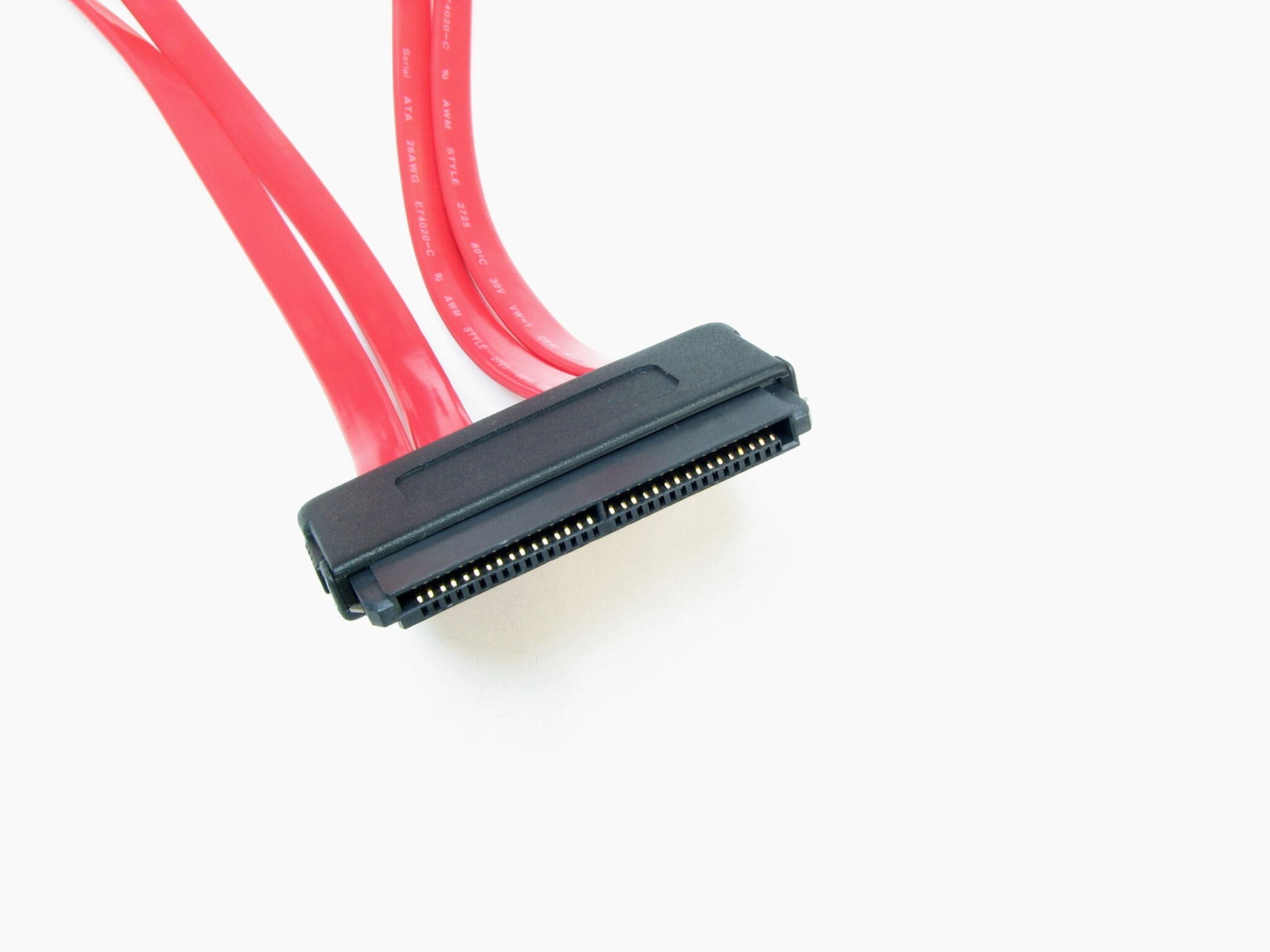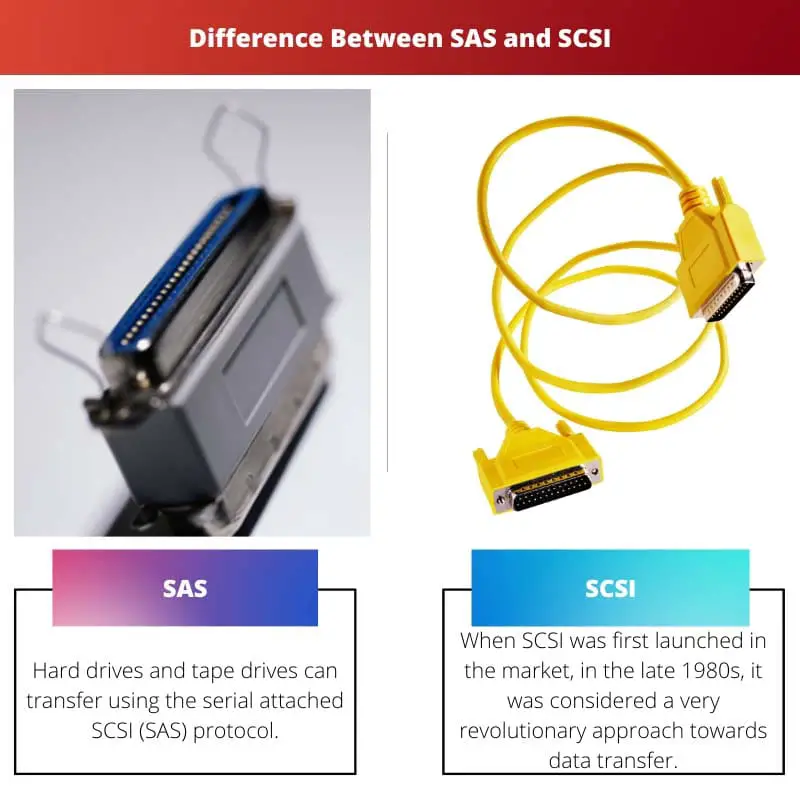Various storage devices use different technology to transfer data to and from computers or other devices. Serial Attached SCSI (SAS) and SCSI are the most common interfaces for connecting peripheral storage devices to a computer.
Both technologies are used for different storage purposes per capacity, speed, and requirements.
Key Takeaways
- SAS (Serial Attached SCSI) is an updated version of SCSI, offering faster data transfer speeds and better scalability.
- SAS supports SATA and SAS drives, whereas SCSI only supports SCSI drives.
- SCSI is less expensive but has been largely replaced by SAS in modern storage systems due to its improved performance and flexibility.
SAS vs SCSI
The difference between SAS and SCSI is that SAS is a much-upgraded technology that has evolved from the existing SCSI storage drives. In SAS, the point-to-point link has been introduced for serial communication over the traditional parallel connection of the SCSI storage technology. The transfer rate and capacity of SAS are also much higher than SCSI.

When SAS was introduced in the market, its data transfer rate was 3.0 Gbit/s. Compared to the latest version today, the transfer rate has increased by fifteen folds.
A typical SAS system comprises four main components: an initiator, a target, a service delivery subsystem, and expanders.
SCSI is more appropriate for storage devices like DVD drivers, CD writers, scanners, etc. It is used to deliver data faster, but its capacity is small.
The SCSI protocol uses a controller responsible for transferring data between various devices and the SCSI bus.
Comparison Table
| Parameters of Comparison | SAS | SCSI |
|---|---|---|
| Full-Form | SAS stands for Serial Attached SCSI. | SCSI stands for Small Computer System Interface. |
| Invention | SCSI is a standard interface that helps connect and transfer data between computers or other peripheral devices. | The first version of SCSI (SCSI-1) was invented in 1986. |
| Definition | SAS is an evolved technology of SCSI devices that transferred from parallel interface to point-to-point links. | Both the external and internal transmission rates are higher and can reach up to 10000 RPM. |
| Data Transfer | The latest version of SAS being developed (SAS-5) has a data transfer rate of 45 Gbit/s. | SAS can connect up to 128 devices at a single time, and it also allows hot plugging. |
| Device Connection | SAS devices have much larger capabilities. | SCSI can connect up to 16 peripheral devices using a single bus and a host adapter. |
| Capacity | This is an ideal solution for businesses that require the storage and archiving huge amounts of data. | SCSI has comparatively less capacity than SAS. |
| Duel Operation | SAS supports full-duplex mode operation for maximum data throughput. | SCSI supports half-duplex mode operation. |
| Use | This is an ideal solution for businesses that require the storage and archiving vast amounts of data. | It is used in enterprise computing with high-end workstations. |
What is SAS?
Hard drives and tape drives can transfer using the serial attached SCSI (SAS) protocol. It is a point-to-point communication technology responsible for sharing data to and from various computer storage devices.
It is comparatively a new technology than SCSI and has a transfer rate of up to 45 Gbit/s. In SAS, the parallel SCSI was replaced by point-to-point links because the latter can reduce address conflicts.
It also ensures maximum bandwidth for which the device is connected by providing them with individual signal paths.
SAS is incorporated with advanced data transmission mode as it supports full-duplex mode than maximizing the effective data throughput.
SAS is also known for connecting several devices (up to 128) at the same time but with the help of expanders; it can join several thousands of devices at once.
SAS also has the advantage of hot-plugging, which allows the creation of alternative pathways for data transmits. It also eliminates the clock skew issue that exists in the SCSI protocol.
SAS can be used in compact systems (hard drives), and due to its large storage capacity, it is used in businesses for data archiving purposes.
It also offers compatibility with SATA (Serial ATA) from version 2 and above. It also features dual ports that allow redundant backplanes or multipath I/O.

What is SCSI?
When SCSI was first launched in the market in the late 1980s, it was considered a revolutionary approach towards data transfer.
The original SCSI technology used a parallel bus which evolved after almost two decades to serial point-to-point combinations and was released as SAS.
The controller used in the SCSI system is either attached inside the motherboard or to a host adapter that is connected via the expansion slot in the motherboard.
This type of system has a SCSI bus, and each device is assigned a specific number in these SCSI buses.
There are two types of buses, narrow buses, and broader buses. The little bus has a number from 0 to 7, whereas the wider bus has a number from 0 to 14.
The number assigned to each device is known as SCSI ID. And the device from or to which data transmission takes place is connected to the CPU through interfaces and buses.
In SCSI, the average access time is concise and is known for very high RPM. SCSI is also a very reliable technology that is used in high-end workstations.
It is also known for shallow CPU usage,, and instated of hot plugging; it has the feature of hot-swapping.

Main Differences Between SAS and SCSI
- SAS is an evolved version of SCSI launched in 2004, whereas SCSI was launched in 1986.
- SAS is an upgraded technology of SCSI devices that transferred from using the parallel interface to point-to-point links, whereas SCSI is a standard interface that helps connect and transfer data between computers or other peripheral devices.
- The data transfer rate of SAS is in gigabytes, whereas for SCSI, it is in megabytes.
- SAS can connect up to 128 devices at a single time and it also allows hot-plugging whereas SCSI can connect only up to 16 devices using a single bus.
- SAS devices have much larger capacities as compared to SCSI.
- SAS supports full-duplex mode operation for maximum data throughput, whereas SCSI uses half-duplex mode to operate.






